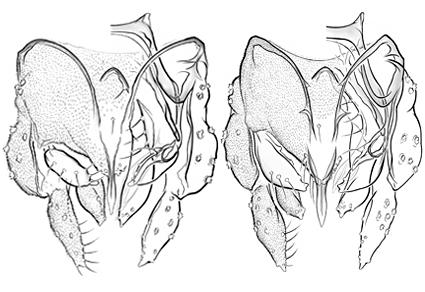Abstract
Two species of the genus Tanytarsus van der Wulp, 1874 are described: T. deimos Giłka, Dantas et Andersen, sp. nov. (Mexico, Panama) and T. phobos Dantas, Giłka et Andersen, sp. nov. (Peru). Small adult males having wings with a high venarum ratio, unpaired tibial spurs on mid and hind legs, a hypopygial anal point lanceolate without spinulae or bars, a digitus with a well-developed basal tubercle bearing a long seta, a stout median volsella, and a gonostylus distinctly shorter than the gonocoxite, are a set of characters common to the two close species for which a new group is here proposed.
References
- Brack, A.E. & Mendiola, C.V. (2004) Ecología del Perú. Ed. Bruño, Lima, 495 pp.
- Dantas, G.P.S., Amat, G., Hamada, N. & Giłka, W. (2022) Towards the systematics and diversity of Neotropical Tanytarsus van der Wulp (Diptera: Chironomidae): news from Colombia. Zootaxa, 5129 (4), 505–529. https://doi.org/10.11646/zootaxa.5129.4.2
- Dantas, G.P.S., Hamada, N. & Giłka, W. (2023) Tanytarsus van der Wulp (Chironomidae, Diptera): new species from the western Amazon region in Peru and Brazil, new records from the Neotropics, and remarks on the taxonomy of the genus. Zootaxa, 5271 (1), 115–139. https://doi.org/10.11646/zootaxa.5271.1.4
- Giłka, W. (2008) A rapid technique of producing spatial colour illustrations of diagnostic structures in small dipterans. Dipteron, Bulletin of the Dipterological Section of the Polish Entomological Society, 24, 8–10.
- Giłka, W. (2010) A new species group in the genus Tanytarsus van der Wulp (Diptera: Chironomidae) based on a fossil record from Baltic amber. Acta Geologica Sinica, 84, 714–719. [English Edition] https://doi.org/10.1111/j.1755-6724.2010.00249.x
- Giłka, W. (2011) Ochotkowate - Chironomidae, plemię: Tanytarsini, postaci dorosłe, samce. Klucze do oznaczania owadów Polski. [Non-biting midges - Chironomidae, tribe Tanytarsini, adult males. Keys for the Identification of Polish Insects]. No 177, part XXVIII, Muchówki-Diptera, zeszyt 14b. Polskie Towarzystwo Entomologiczne, Biologica Silesiae, 2011, 1–95. [in Polish]
- Giłka, W. & Paasivirta, L. (2009) Evaluation of diagnostic characters of the Tanytarsus chinyensis group (Diptera: Chironomidae), with description of a new species from Lapland. Zootaxa, 2197 (1), 31–42. https://doi.org/10.11646/zootaxa.2197.1.3
- Giłka, W., Zakrzewska, M., Dominiak, P. & Urbanek, A. (2013) Non-biting midges of the tribe Tanytarsini in Eocene amber from the Rovno region (Ukraine): a pioneer systematic study with notes on the phylogeny (Diptera: Chironomidae). Zootaxa, 3736 (5), 569–586. https://doi.org/10.11646/zootaxa.3736.5.8
- Kyerematen, R.A.K. & Andersen, T. (2002) Rheotanytarsus Thienemann et Bause (Diptera: Chironomidae) from Central America and Mexico. Studies on Neotropical Fauna and Environment, 37 (1), 23–51. https://doi.org/10.1076/snfe.37.1.23.2113
- Pulgar-Vidal, J. (1996) Geografía del Perú. Las ocho regiones naturales. La Regionalización Transversal. La Sabiduría Ecológica Tradicional. 10ª Edition. Peisa, Lima, 218 pp.
- Reis, P.R., Gil-Azevedo, L.H. & Ferreira-Keppler, R.L. (2021) Two new species of Tanytarsus van der Wulp (Diptera: Chironomidae) from Costa Rica. Zootaxa, 4966 (1), 84–90. https://doi.org/10.11646/zootaxa.4966.1.9
- Reis, P.R., Lin, X-L. & Ferreira-Keppler, R.L. (2022) Three new species of Tanytarsus van der Wulp (Diptera: Chironomidae) from the Amazon rainforest. Zootaxa, 5194 (3), 426–434. https://doi.org/10.11646/zootaxa.5194.3.6
- Sæther, O.A. (1969) Some Nearctic Podonominae, Diamesinae and Orthocladiinae (Diptera: Chironomidae). Bulletin of the Fisheries Research Board of Canada, 107, 1–154.
- Sæther, O.A. (1980) Glossary of chironomid morphology terminology (Diptera: Chironomidae). Entomology scandinavica, Supplement 14, 1–51.
- Zakrzewska, M., Andersen, T. & Giłka, W. (2023) Mimes of the past: Eocene midges of the tribe Pseudochironomini (Chironomidae, Diptera) reveal their peculiarities. PLoS ONE, 18 (12), e0295841, 1–22. https://doi.org/10.1371/journal.pone.0295841


